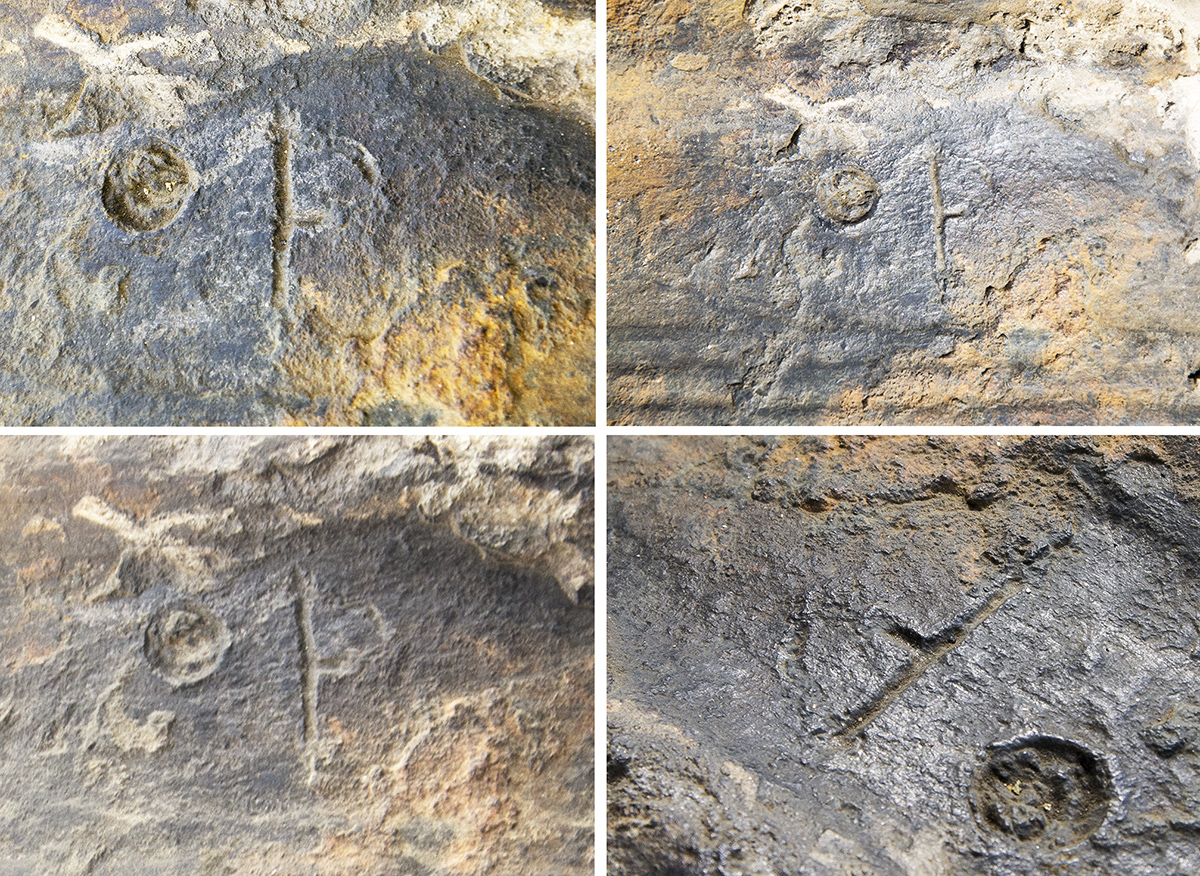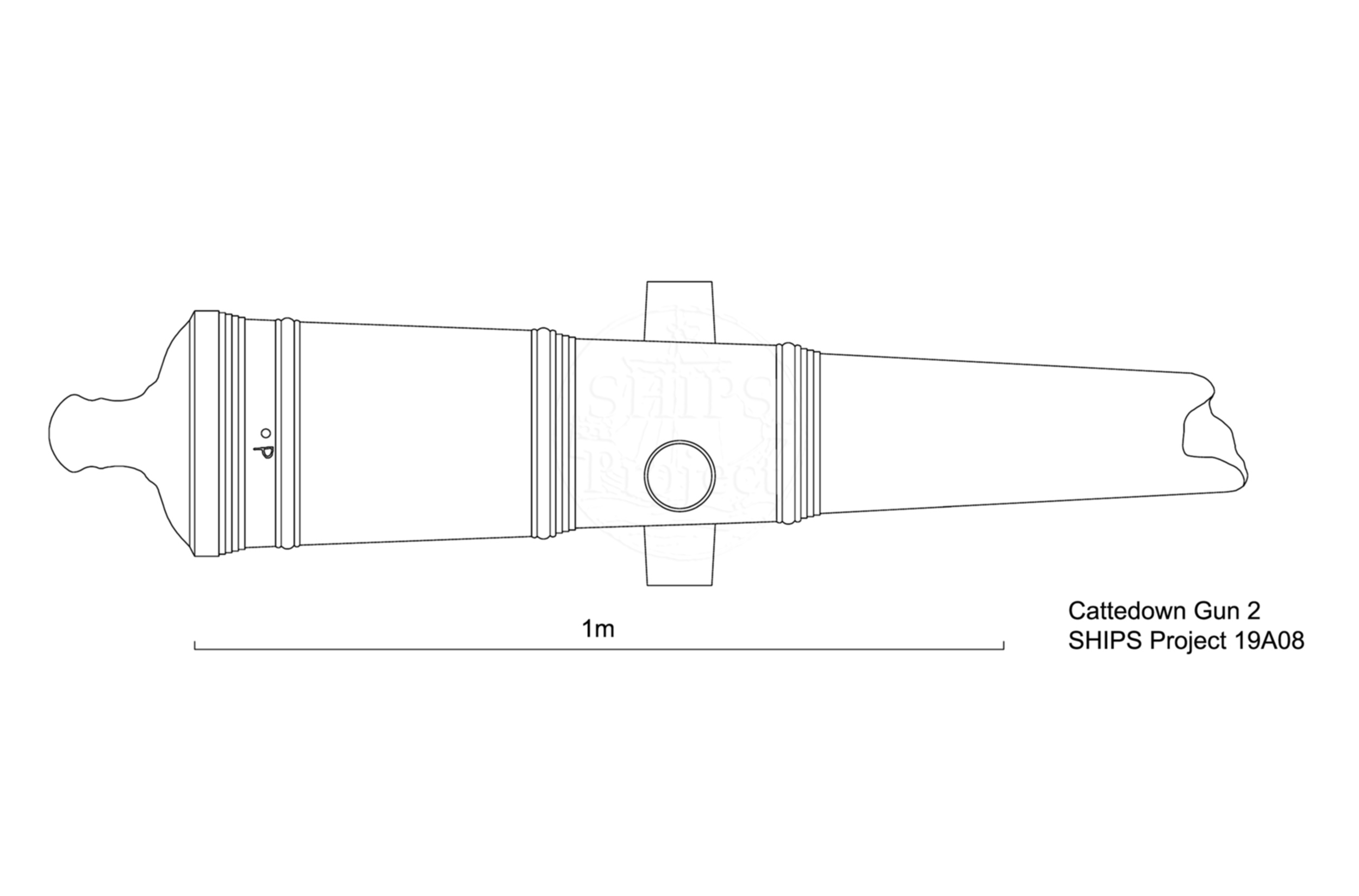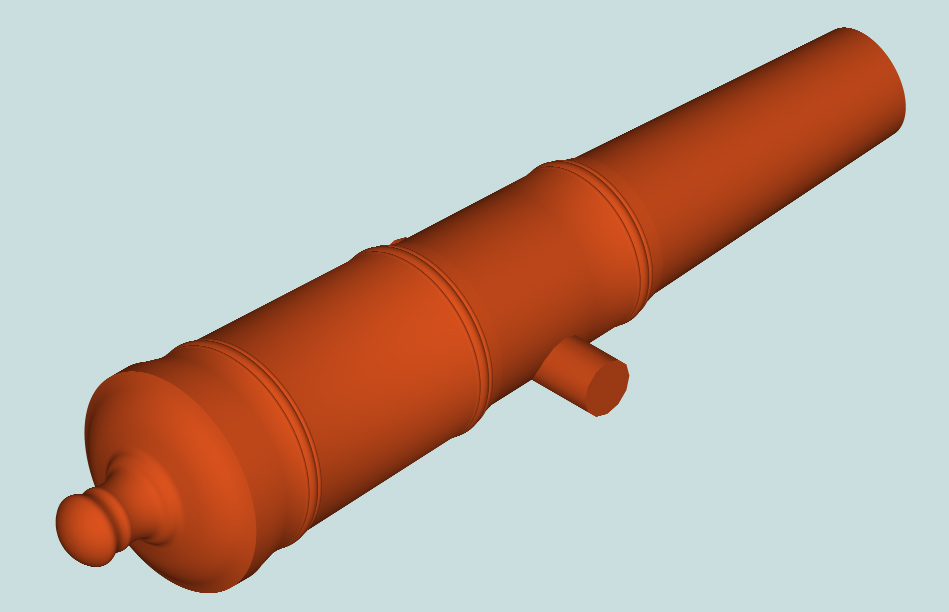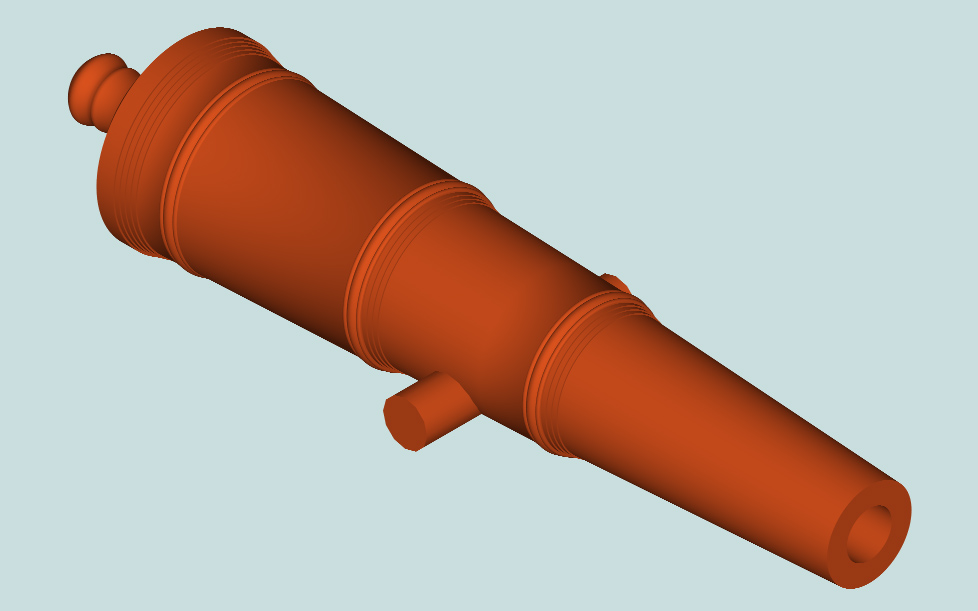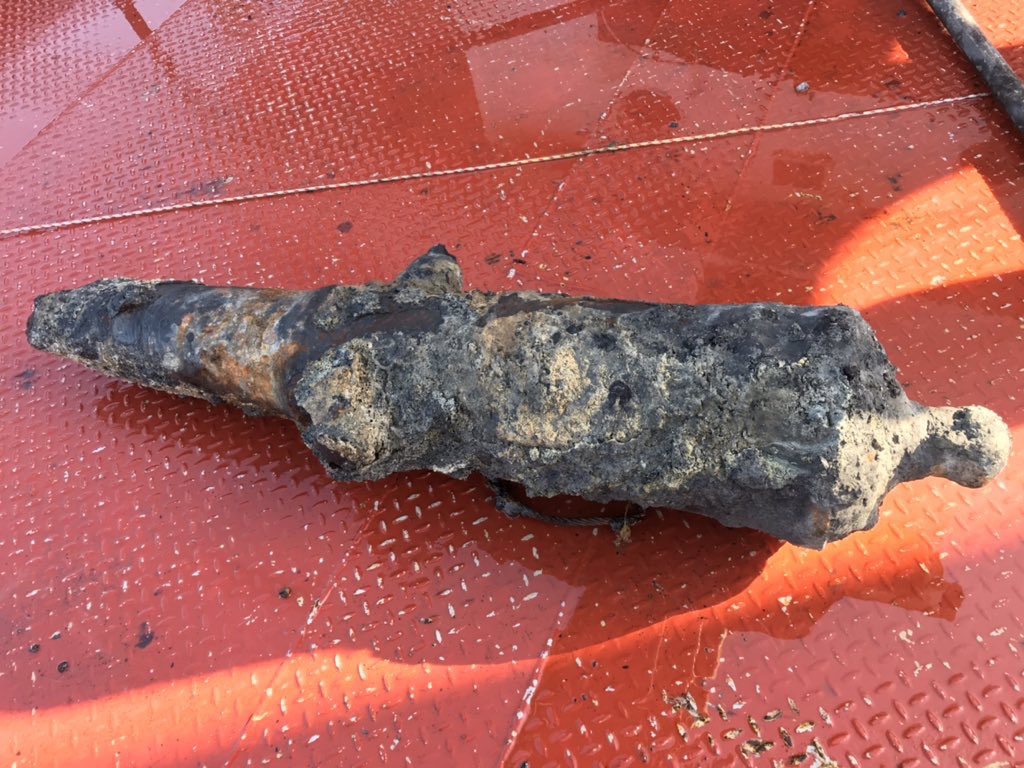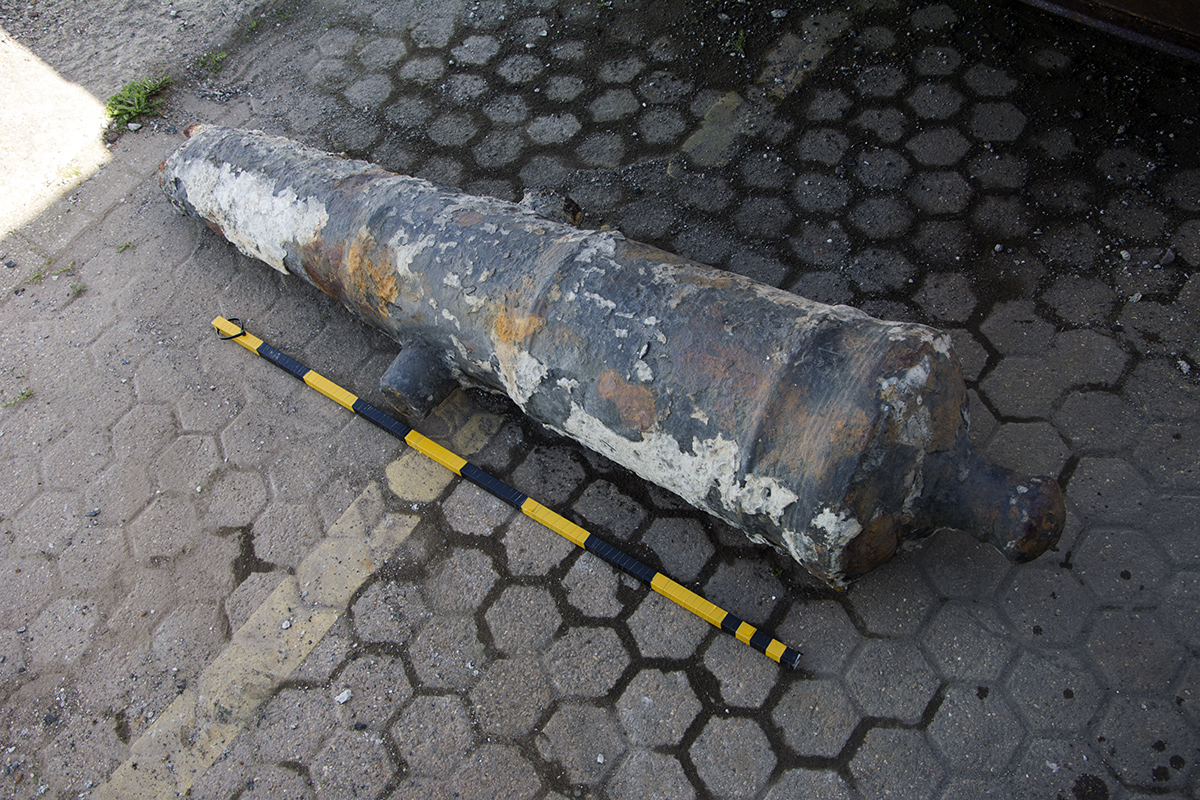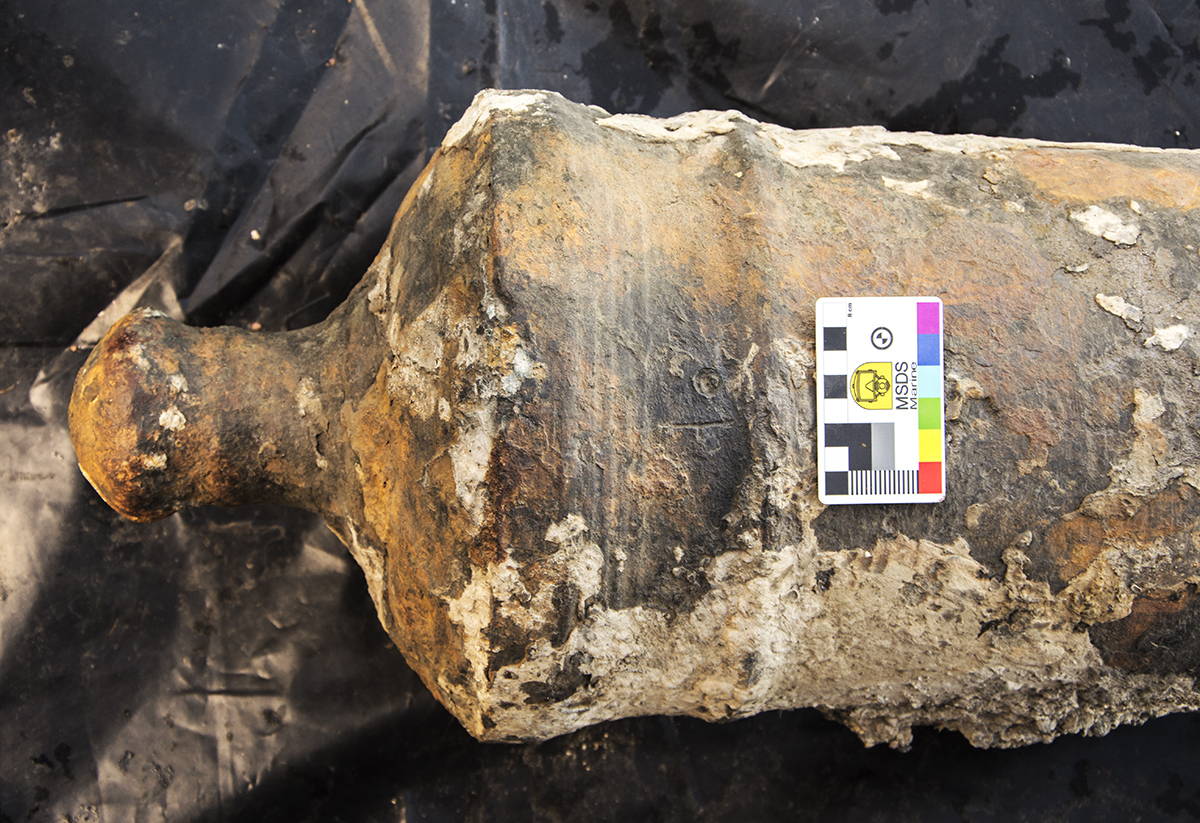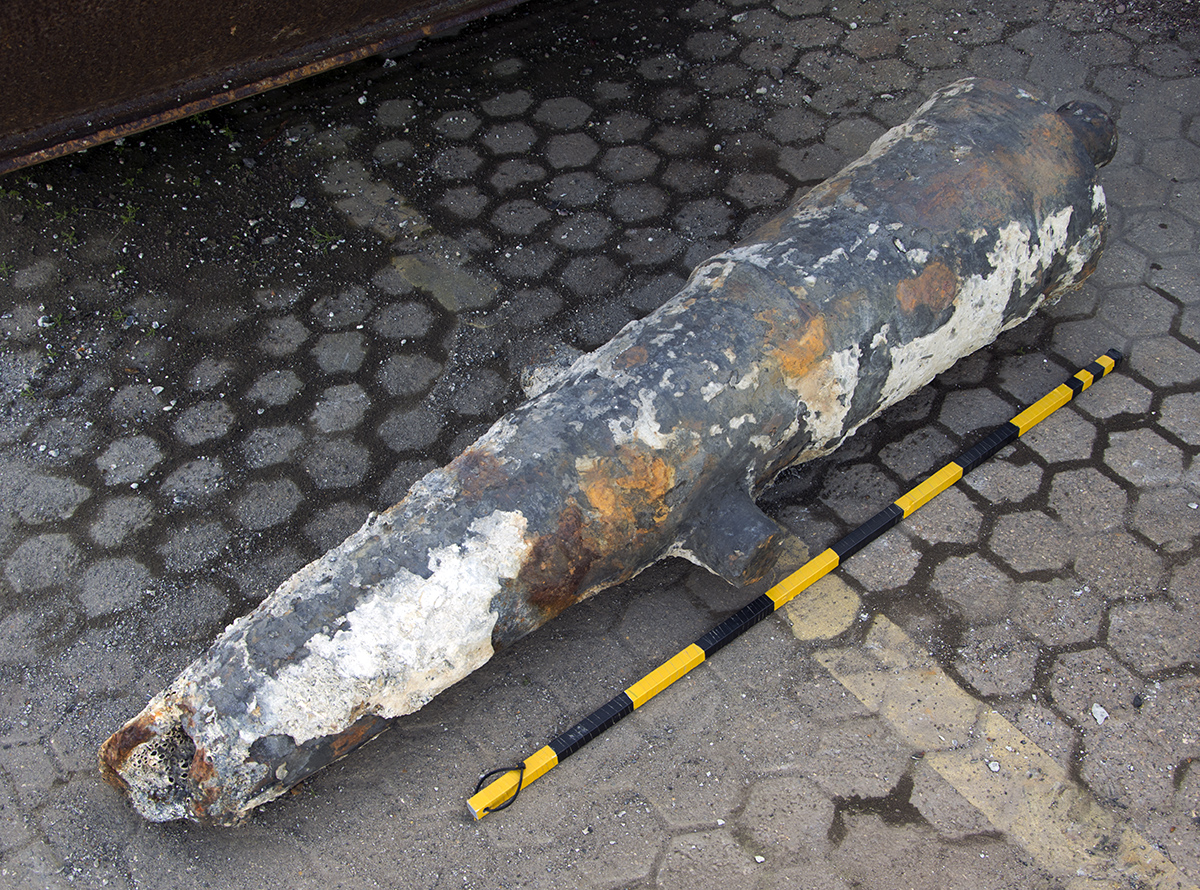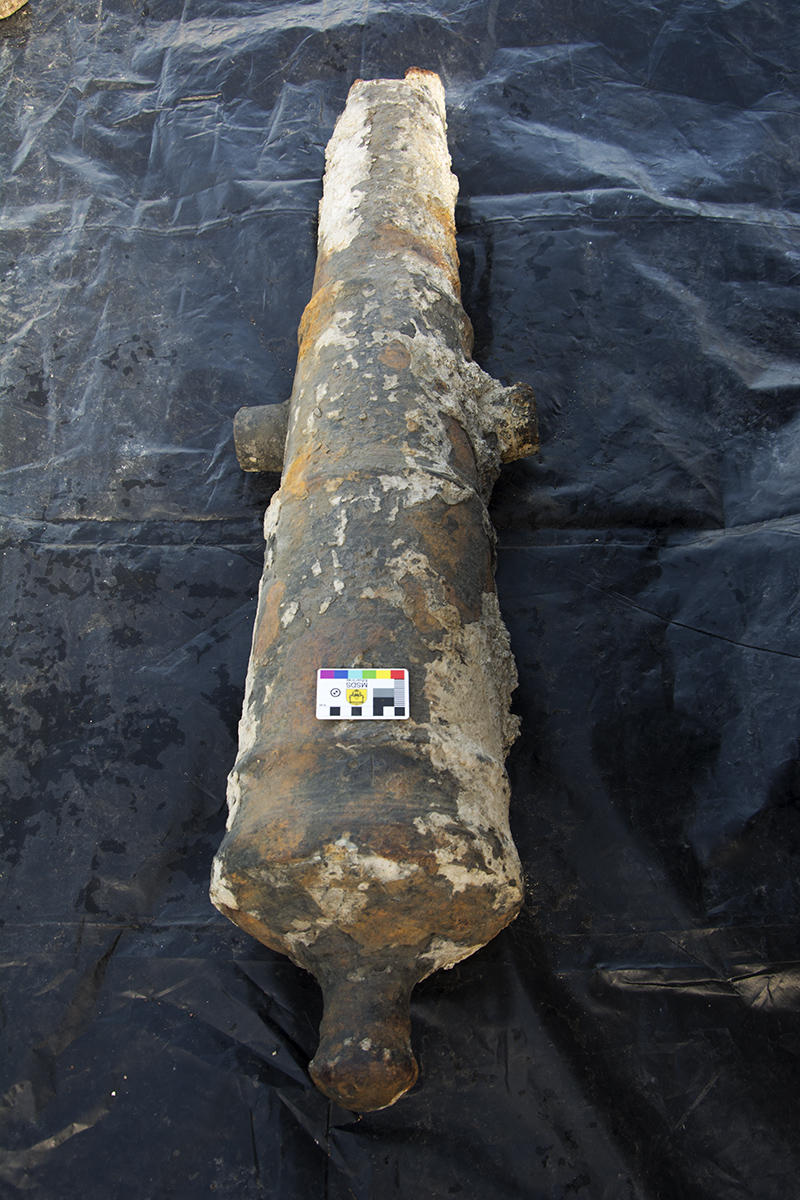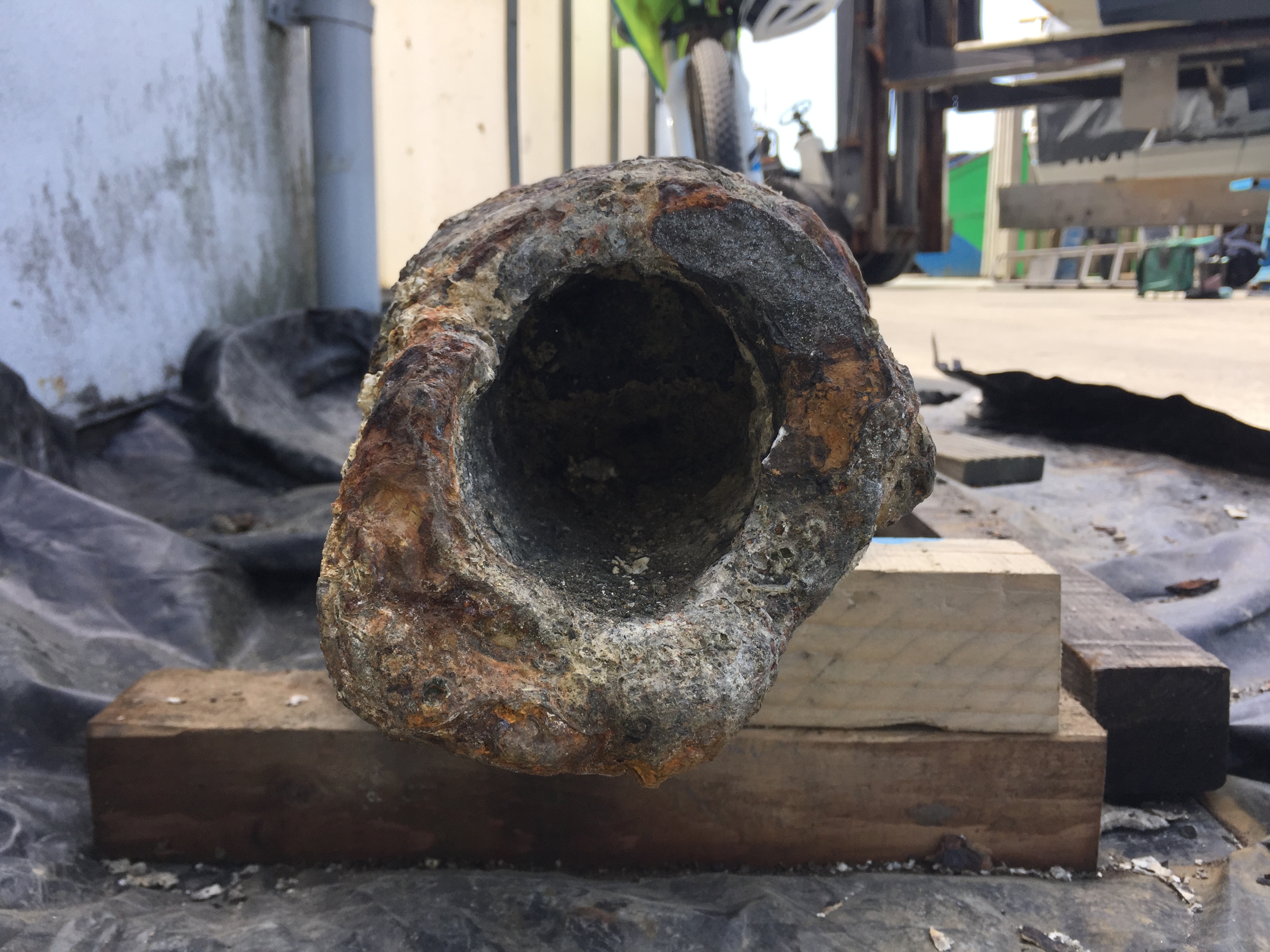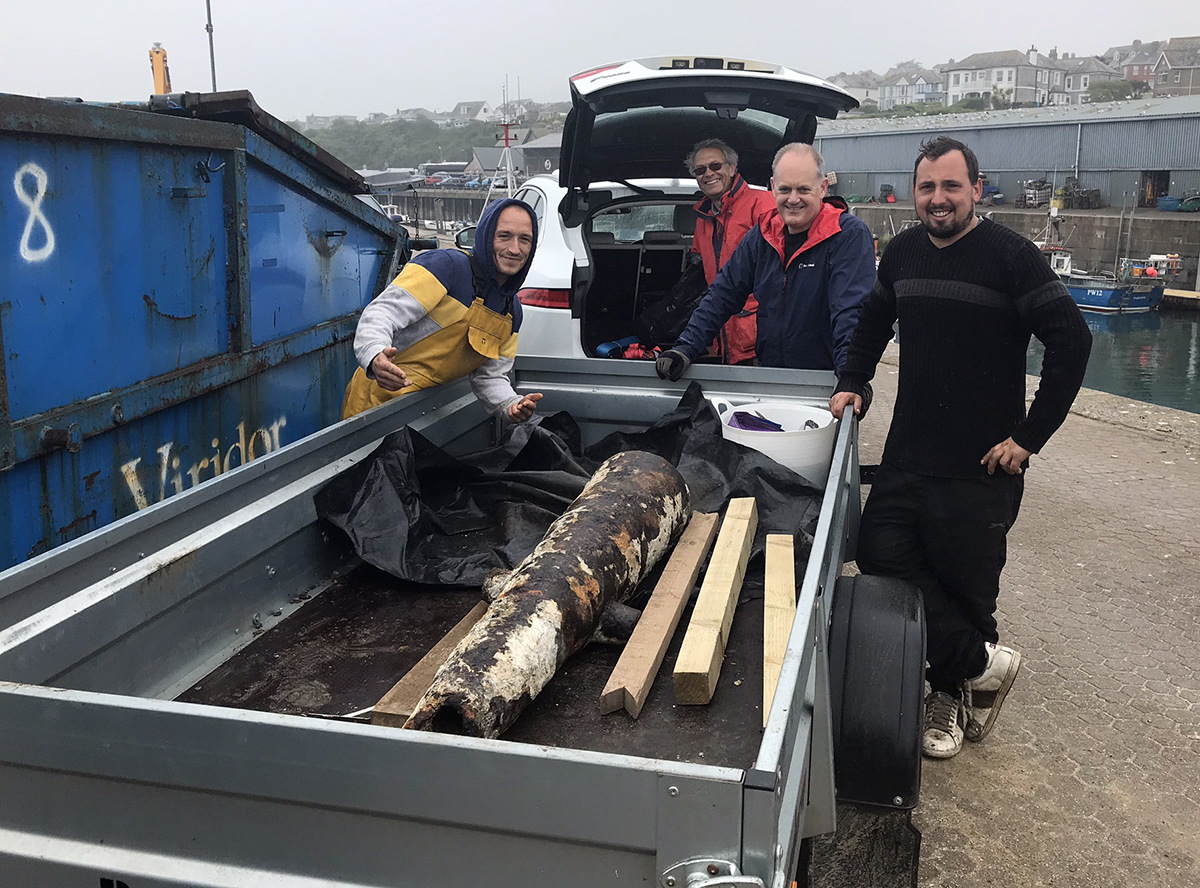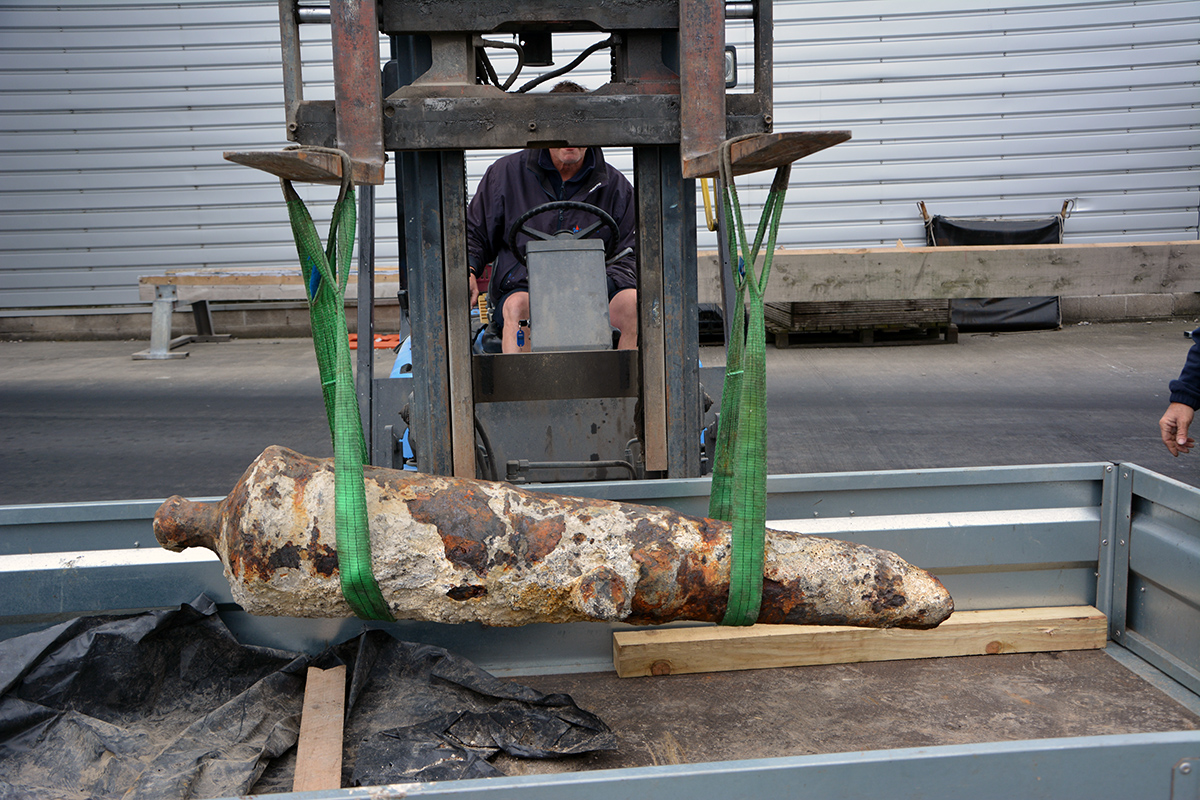The Cattedown Cannon (19A08)
Background
In April 2019, a small and badly eroded cast iron gun was recovered during dredging work off Cattedown Wharves in Plymouth. The work was being done as part of the on-going maintenance dredging for the Cattewater Harbour Commissioners. We were informed by local divers that the gun had been recovered however we were not in the country at that time so could not inspect it. On our return to Plymouth we were informed that the captain of the dredger had been allowed to take the cannon with him when the boat finished the dredging work. We got in contact with the captain who told us that he intended to give the cannon to a sport diving centre in North Cornwall and that the gun was still on the deck of his ship, not kept wet and not protected from the sun. During a later call to the dredger captain to arrange to see the gun, we were told that it had since been placed on a public quay, so we now had access to the gun and could photograph and record it.
The Receiver of Wreck was notified of this recovery.
Recording the Gun
The gun had been placed on the quay under a dredge grab which made recording difficult.
The gun was mostly intact but with the muzzle missing. The corrosion products covering the surface at the breech end of the gun formed a thin and hard concretion. Right side of the gun was covered in a layer of modern cement with the remains of a wire rope embedded in it, the cement presuably having been dropped from ships unloading above. The breech end was in good condition overall, the outer surface has small areas of pitting but the gun still shows all its detail in the mouldings. However there is considerable damage and erosion forward of the trunnions, the muzzle is missing and the broken end of the gun is eroded. The bore is full of concretion and cement.
The remaining part of the gun without the muzzle is 1.47m (57.87in) long, the base ring diameter is 304mm (11.97in) and the distance between the base ring and the centre of the trunnions is 600mm (23.62in). The distance between the base ring and the end of the cascabel is 186mm (7.32mm) and the shape of the cascabel is shown in Figs. 4 & 5. The breech mouldings are smooth with no well-defined rings or hard edges. The base ring is 30mm (1.18in) wide as are the stepped mouldings just forward, the vent astragal and the reinforce rings.
The 68mm (2.68in) long trunnions are tapered, being 84mm (3.31in) diameter close to the barrel and 79mm (3.11in) diameter at the ends, they have a width of 378mm (14.88in) and their centre is offset from the bottom of the gun by 60mm (2.36in). The bore diameter is 77 to 79mm (3.03 to 3.11in) allowing for damage and corrosion, so it appears to be a minion that would fire a 3.75lb shot.
There is a single mark on the gun, to the right of the touch hole 22mm x 12mm (0.87in x 0.47in) in size; the mark appears to be a 'P' however it has been suggested that this mark may alternatively be a 'B' (Fig. 6).
The gun appears to have been lying on the seabed with the right side uppermost, breech buried in the seabed and with the muzzle exposed. Some damage was done to the gun when it was recovered by the dredger.
The gun now known as Cattedown Gun 2 was given finds number 'SHIPS 19A08' then added to The SHIPS Project archive.
The drawing of the gun was rendered in 3D to show the overall shape, the position of the trunnions and the smooth form of the breech:
The Cannon Found in 1887
Records in The SHIPS Project archives included an account of another gun having been recovered from the same area off Cattedown Wharves in 1887, along with extensive remains of an armed wooden sailing vessel.
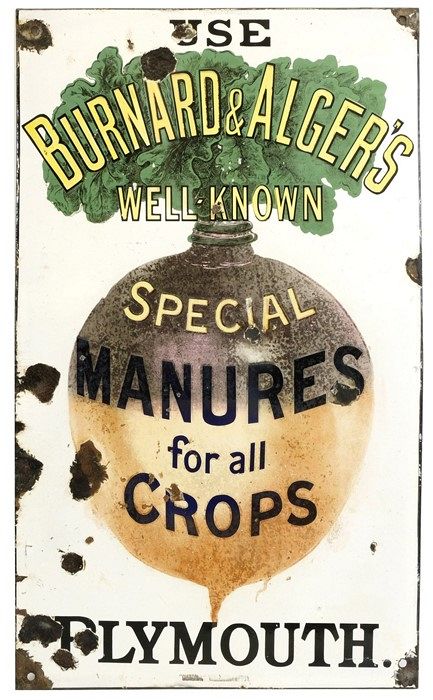
Fig 10: Early advertisement for Burnard and Alger
In the early 1880s, Burnard and Alger operated an 'artificial manure' works in Cattedown and were large importers of raw materials. The original Cattedown quay they used was designed for small sailing vessels to load limestone from the quarry behind, it was small and in a state of disrepair so vessels had to anchor in the river and send their cargoes in to the quay by lighter. To remedy this problem, Burnard and Alger bought part of the foreshore from the Duchy of Cornwall and an Act of Parliament was obtained in 1887 for the development of public wharves and associated warehouses. Seven acres of the Cattewater in front of the wharves were dredged to allow bigger ships to remain alongside the dock at low tide; the dredging removing 114 thousand tons of silt, rubble and rock over six months, increasing the water depth off the quay to 24ft (7.3m) at low water ordinary spring tides. By 1888 a timber jetty had been built out over the original slipways and quays which was 521ft (158m) long and 30ft (9m) wide and could accommodate vessels up to 3000 tons. The site became known as Burnard and Alger's Wharves.
During the dredging work they uncovered a shipwreck buried within the seabed and recovered a single iron gun. Burnard provides a detailed description of the dredging work and the shipwreck they salvaged in the Annual Report and Transactions of the Plymouth Institution:
'The length of the wreck appeared to be about eighty to ninety feet (24m to 27m) long and prior to dredging it was entirely covered in silt. Before disturbance by the dredger, the timbers were framed and in place, just apparently as she lay when misfortune overtook her. A considerable portion of the keelson was recovered, buried ten feet (3m) under the surface of the mud.
The removal of this timber was very troublesome and difficult, delaying operations; for after each assault of the dredger, the detached portions had to be found by a diver and brought to surface. In this manner a barge-hold full of various sorts and sizes of oak and beech was collected. Resting on the wreck was a large amount of ballast, consisting of large, heavy, water-worn pebbles and flints. It was estimated that about 240 tons of the former and ten tons of the latter were dredged and discharged into hoppers.
I am indebted to Mr G. F. Watson for a shipbuilder's opinion on the timber. He reports examining stem, keelson, with mast step and many floors, futtocks, timbers, and planks, of rough workmanship. Abundance of timber was evidently used in the construction, the scantlings being sufficient for a craft of 300 tons register, according to modern rules; the room and space 23 to 24 inches (697mm) from the seating of the floors, roughly chipped out of the dead wood. All the timbers are English oak and the planking beech, of 2.5 inches (64mm) or half an inch to three-quarters of an inch less than modern requirements; the keelson 14 inches (356mm) sided, and about the same moulded. The floors were evidently attached to the keel with iron bolts, but no other portions seem to have been connected with iron. The probability is that the vessel is short, deep and broad, and the longitudinal was apparently deemed of second consideration to the transverse strength. The heavy framing may have been required from the rough way it was put together. Timbers are not well squared, and scarphs short in stem and keelson. No chocks appear to have been used.
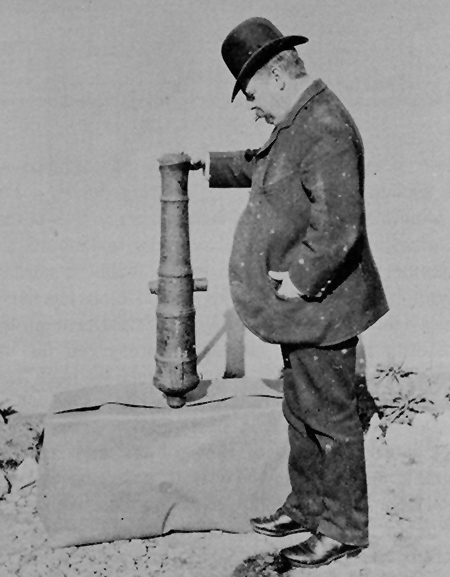
Fig 11: Burnard photographed with Cattedown Gun 1
After expressing his inability to determine the age of the ship, Mr Watson considers the wreck to represent a vessel of about 300 tons burthen - not a man of war and no great age; but how she became buried so deep in the silt is a problem he consigns to the tender mercies of geologists. Fortunately for the peace of mind of these gentlemen, evidence has been fished up which indicates that the age of the vessel is about 250 years. This is borne out by Mr Watson's description of the timbers; and his opinion that the vessel was comparatively short, deep and broad, and of great transverse strength, thus enabling it to carry with greater security the enormously high stern superstructures in vogue both in men-of-war and merchant ships of the seventeenth century, tallies with the estimate of the age.'
Later the report goes on to say: 'Not a trace of anchors or cables came to light. The only discoveries made in situ were a wooden block, the remains of a wooden shovel, and a round copper cover. The former were near the surface , but the cover was found ten feet below the harbour level of the silt.'
The report notes that a gun was found also marked with a letter 'P' and its weight: 'When hope was almost abandoned, the buckets fished up what appeared to be a mud-laden piece of timber, which fell with a thud on the shute, and fortunately rolled from it on to the deck of the hopper. A slight examination discovered the small cannon now exhibited; and after a thorough cleansing and examination this was found to be a cast-iron gun marked with the letter P, and its weight 1cwt. 0qrs. 3lbs. The total length of the gun is 2 feet 9.25 inches; diameter of bore 1.75 inches. Greatest circumference of muzzle 15 inches; smallest circumference 11.5 inches; circumference at vent 17.5 inches. present weight 110.5 lbs, or 4.5 lbs less than the original weight.
On probing the bore, it was found to be loaded; and with some patience oakum wadding, a cast iron ball of just half a pound weight, more wadding, and the remains of a powder charge, consisting of charcoal and sulphur (all the soluble nitre being, of course, washed out), were extracted.'
A discussion about the origin of the gun is discussed in the report on pages 408 to 410. The report goes on to say that: 'Bearing in mind that this was charged with powder and shot drives us to the conclusion that the vessel carrying it inside the harbour must have been engaged in actual warfare; since the gun has evidently been dismounted by a longitudinal shot; for on examination it is clearly seen that it has received on one side a heavy blow on the muzzle, trunnion and breech.'
Gun 1 is different in style to Gun 2 with what appears to be a shorter cascabel, a vent patch, square reinforce rings and parallel trunnions.
Burnard suggests that the ship was lost during the lengthy siege of Plymouth during the English Civil war when the port of Plymouth was besieged from 1642 to 1646 by Royalist forces loyal to King Charles I: 'Receiving serious injury she was run ashore under the cover of the guns of the Cattedown work, dismantled, all her guns and gear removed, and the superstructure carried away down as far as low water would permit. She was in shallow water, clear of the channel, and would be of no inconvenience or danger to navigation. There, with her ballast sitting heavily on her, or at least what remained of her, she slowly sank in the mud, and was gradually covered up by the natural tidal silt, and the operations of the busy stream-tinners who vigorously fouled the Dartmoor rivers down to the time of Queen Anne.'
Burnard offered the gun and other finds to the Council to be placed in the Plymouth Athenaeum. The Athenaeum was destroyed during the Plymouth Blitz and the gun was taken from the ruins by workmen mistaking it for scrap iron.
Location
Cattedown Wharves are on the north side of the Cattewater in the river Plym, on the east side of Plymouth. The wharves are in regular use for the shipping of grain/feedstuffs, dry bulk cargoes, oil and petroleum and general cargo. The maintained depth alongside the wharf is 7.6m to the west and 6.3m to the east and it was during maintenance dredging alongside the wharf that Gun 2 was recovered.
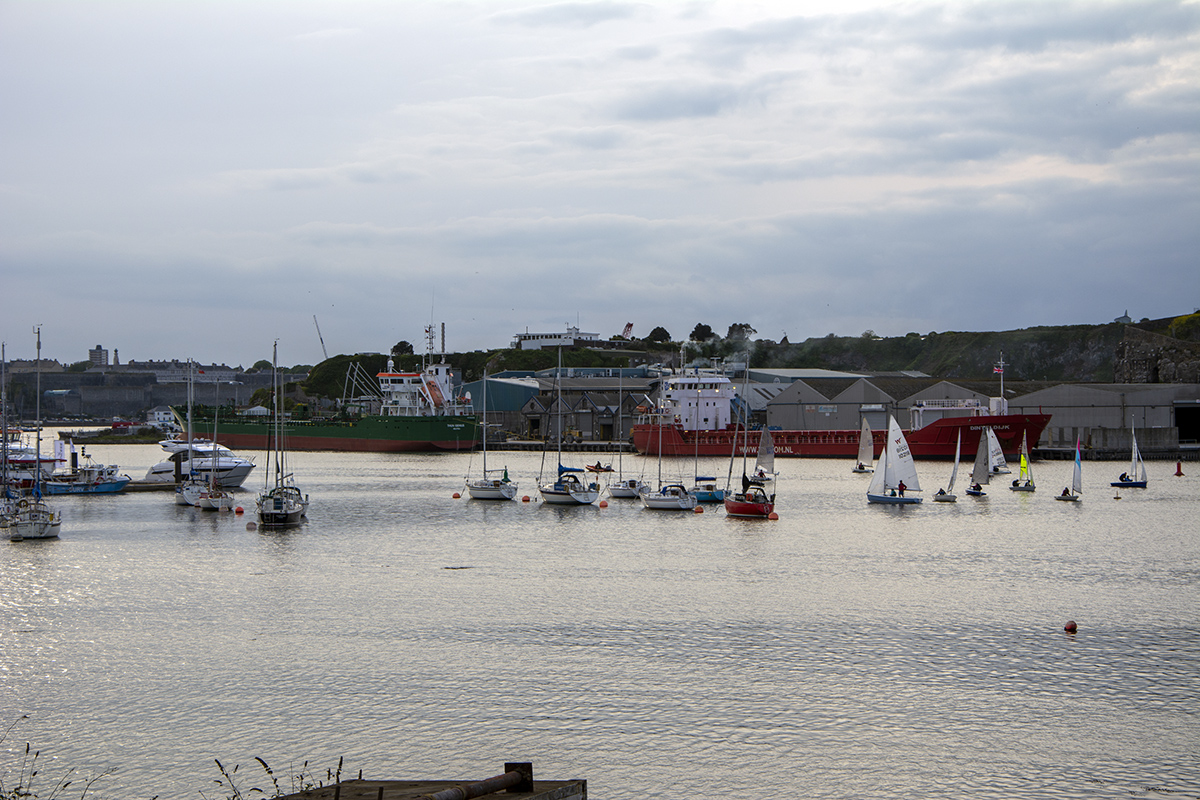
Fig 13: Cattedown wharves as seen from Oreston
The 1887 report suggests that the wreck was found close to the wharf: 'the position of the wreckage was found 20 feet west of the Cattewater mooring chain and twenty feet south of the line of the Cattedown Wharves, with the stem pointing towards Cattedown'. This places the 1887 wreck on a line 225m long between 50° 21.680 N 004° 07.130 W and 50° 21.698 N 004° 06.943 W (WGS84). The position where Gun 2 was recovered from has been provided by the captain of the dredger and it is in agreement with the original position estimate..
An analysis of depths in the river taken from old charts may tell us more about the site formation processes affecting the shipwreck.
Note that diving is restricted in this area and permission to investigate the site must be obtained from the Cattewater Commissioners.
References
- Burnard R., 1887, Recent Dredging in Cattewater, in the Annual Report and Transactions of the Plymouth Institution, Vol. IX, Part III, 1886-87, W. Brendon & Son, Plymouth
To get in touch with The SHIPS Project please send us a message below:
Leave a message
Your email address will not be published.
Click the images for a larger version
Image use policy
Our images can be used under a CC attribution non-commercial licence (unless stated otherwise).
